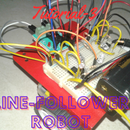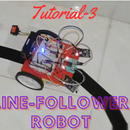Introduction: ' LED FLASHLIGHT ' From Trash
Hello Guys,
Today in this instructable I made a new bright LED flash light from old filament bulb torch. Some day before, in a cleaning work, I saw a good looking beautiful torch in my house. But it is not in working condition. I found that its bulb is fused. This torch contains a filament bulb. So I decided to modify it into a new one. So I decided to place an LED instead of filament bulb. But there is a problem, the torch is designed for two AA cells. So the white LED is not work good in this voltage. So I decided to make boost converter for light-up the LED from a small voltage and I replace the cells by using two NiMH cells. The NiMH cells also have a lower voltage than the previous ones. But the boost converter overcome this problem. So here I made a simple boost converter made by using a single transistor and it works very well from 1.5V. So it is works very well in this flash light. So I successfully modify an old torch light to a new rechargeable LED flash light.
Step 1: Materials & Tools
The materials Needed
One old torch, Old convex lens with small focal length, resistors, transistor, capacitor, diode, inductor core (torroidal ferrite), enameled copper wire, cello tape, NiMH cells, etc...
All the electronic components are SMD components. These all are reused from old PCBs. It is taken from old PCBs and with out making any damage to the components by using de-soldering techniques.
The de-soldering is explain in the above video.
Tools Needed
Soldering iron(micro), Tweezers, solder wire, flux, sand paper, hacksaw blade, small knife, etc...
Step 2: Full Plan & Circuit Diagram
Full Plan
In the above image I tear down the torch. All parts are given in the image. I plan to make a small circuit by using smd components and it is hide inside the torch reflector head (white part) and add a convex lens in front of the reflector to pointing the light. Also I plan to change the nonchargeable cells to a rechargeable cells. This is my plan. First I going to design an efficiently working circuit for it. This circuit works at an efficiency above 80%. For portable products the efficiency is an important concern.
The circuit diagram is given above shows a smallest and simplest boost converter. Boost converter is a circuit which increase the input voltage to a higher level and it given to the output. For more details about boost converter theory please visit my blog. The link is given.
https://0creativeengineering0.blogspot.com/2019/04/5v-boost-converter.html
Circuit Explanation
The main parts are the transistor and the two inductors. The inductors are wind in a same core. One inductor is used for feedback the signal for the working of oscillator. Other is used for the boost converter. The transistor is here used as oscillator and the driver for boost converter. The output section contain rectifier and a filter circuit for make a pure DC voltage. The resistor is used to give a bias voltage to the transistor and it is also start the boost converter working. The capacitor is used to increase the efficiency of the circuit. The correct value of capacitor make the circuit to be an efficient one. If you like to know more about the circuit please visit my blog page. I explain very well in my Blog. Link given below.
https://0creativeengineering0.blogspot.com/2019/04/transistor-boost-converter-for-led.html
Step 3: Inductor Making
First we going to make the inductor. I made the inductor by using hands. The inductor is wind on a round torroidal core. It is taken from old CFL bulb circuit boards. The two inductors are wind in the same core. For inductor making I use a small diameter enameled copper wire. Commonly these wires are used for transformer or small motor winding. Number of turns given in the circuit diagram.
- Take a small torroidal core which fit inside the reflector head
- Wind two inductors in it
- Cover it by using cello tapes
- Remove insulation of the 4 output leads
Step 4: Circuit Testing
In this step I testing the designed circuit. It is a verification step before original PCB making. First I test the circuit by using through hole components (in the first image). The components are connect in a breadboard and connect the battery. The circuit works very well.
Then I made the circuit by using smd components (second image). Because I decided to make the circuit by using smd components.The smd components are connected by using small wires and solder it together. The components are taken from old PCBs. Here the testing is a success one.
Step 5: Custom PCB Making
Here I going to explain about the custom PCB design. Here I make round PCB which is perfectly fit inside the torch reflector head. It has a small diameter. So I made a double sided PCB. But I had only single sided copper clad. So I made double sided PCB from single sided PCBs.
- Cut a square copper clad from large one
- Reduce its thickness by using sand papers
- Cut it into two small round shapes which is suitable for the torch head
- Clean the PCB
Step 6: Etching
Etching is the process of making PCBs from copper clad. Here I made the PCBs by using etching. First I draw the PCB layout to the copper clad by using a permanent marker pen. Then it is put it into the copper sulfate (CuSO4) solution and etch it. The PCB layout is made by using simple thinking process.
- Draw the PCB layout to the copper clad by using permanent marker
- Repeat the drawing work to make a harder layer of mask
- Prepare a copper sulfate solution
- Put the copper clad into it
- Wait for some hours for clear etching
- Remove the marker ink and clean it by using sand paper
Step 7: Soldering
It is the time for soldering. I use a micro soldering iron for soldering it. For component handling I use tweezers. It has a small number of components. So the soldering is a simple job for here.
Step 8: Attaching the Spring
A spring is attached to the central pad in the PCB. It is the positive connection to the PCB. This spring is used to connect the PCB to the battery in a mechanical way. The spring give good tension for the good connection. The spring is soldered to the PCB.
Step 9: Connecting Inductor & LED
It is the time for completing the circuit. Our missing elements are the inductor and the LED. Here I connect the inductor and LED as an order which is given in the above images. First I connect the inductor and connects its lead wires to the PCB in the correct position with respect to the circuit diagram. Then after connect the LED to the PCB by using small wires. And the wire is taken inside through the torroidal inductor. It is because otherwise it is not fit inside the reflector head. Ensure the LED polarity is correct. Now I finish all the circuit parts. For testing connect a single 1.5V cell to it. In my case it is a success one. Otherwise please check the circuit connections ones more.
Step 10: Hide Inside the Reflector
Here I insert the full circuit to the reflector head. It is perfectly hide inside the reflector head. In my opinion it is a perfect one. It has no extra structures other than the filament bulb and it has the same size as the filament bulb placed inside the reflector. So it is a perfect design. Add an extra insulating plastic sheet around the spring to avoid short circuit. OK. We done the main hardware.
Step 11: Attaching Lens to the Torch
The reflector is a plastic one so it don't concentrate the light into a single point it only reflect the light. So I add an extra convex lens instead of the glass cover in the torch head. This lens has a small focal length. The focal length is same as the distance between the lens and the LED. I remove some material from the lens for fitting it into the head cover. So finally I fit it into the torch head.
Step 12: Finished New LED Flash Light
Now it is the time for the final assembly. I fit the from head and insert two NiMH rechargeable battery and fit the bottom part of the light. Now I turn on the switch. Wow..... It works very well..... It produce a bright white light. The light is given in the above images. So finally I successfully created a new rechargeable LED flash light from an old filament torch. It is an awesome one. The amazing thing is that this flash light is a very small one. It is fit in your pocket. This comfortless is the initiative behind this modification work.
Step 13: Battery Charging
For charging the rechargeable NiMH cells. I use a self made two cell charger unit. It is very good for charging the cells. It has a full charge indicator. It is an efficient one. I made it from scratch. I made an instructable and blog about this charger. For more details please visit it.
https://www.instructables.com/id/Ni-MH-Battery-Charger/
https://0creativeengineering0.blogspot.com/2018/12/ni-mh-battery-charger-for-230v.html
Thank you.....

Participated in the
Trash to Treasure











